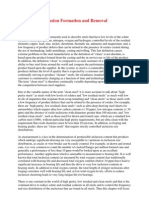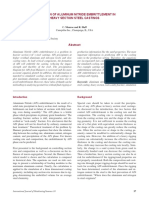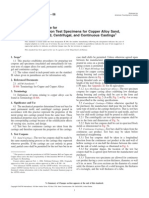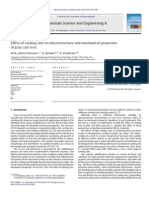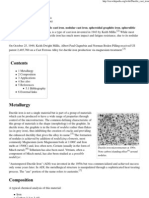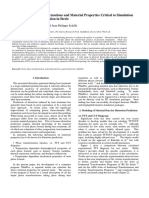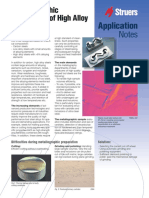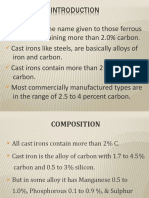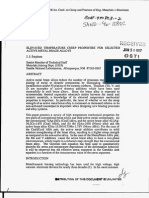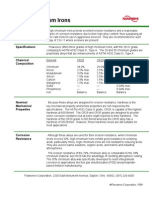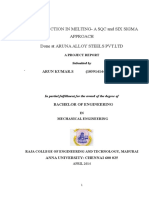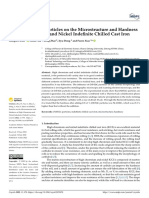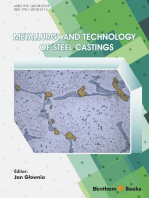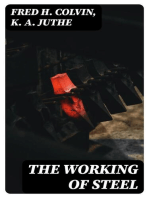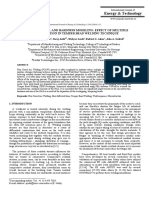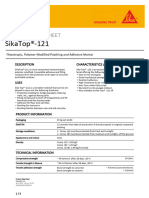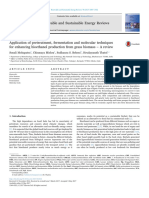Phosphorus Segregation in CR - Mo - V Cast Steel After Regenerative Heat Treatment
Phosphorus Segregation in CR - Mo - V Cast Steel After Regenerative Heat Treatment
Uploaded by
sanketpavi21Copyright:
Available Formats
Phosphorus Segregation in CR - Mo - V Cast Steel After Regenerative Heat Treatment
Phosphorus Segregation in CR - Mo - V Cast Steel After Regenerative Heat Treatment
Uploaded by
sanketpavi21Original Description:
Original Title
Copyright
Available Formats
Share this document
Did you find this document useful?
Is this content inappropriate?
Copyright:
Available Formats
Phosphorus Segregation in CR - Mo - V Cast Steel After Regenerative Heat Treatment
Phosphorus Segregation in CR - Mo - V Cast Steel After Regenerative Heat Treatment
Uploaded by
sanketpavi21Copyright:
Available Formats
ARCHI VES
o f
F OUNDRY ENGI NEERI NG
Published quarterly as the organ of the Foundry Commission of the Polish Academy of Sciences
ISSN (1897-3310)
Volume 9
Issue 1/2009
91-96
21/1
Phosphorus segregation in Cr Mo V cast
steel after regenerative heat treatment
G. Golaski
Institute of Materials Engineering, Czestochowa University of Technology, Armii Krajowej 19, Czestochowa, Poland
*Corresponding author: e-mail: grisza@mim.pcz.czest.pl
Received 26.02.2009; accepted in revised form: 30.03.2009
Summary
The paper presents results of research on the influence of regenerative heat treatment on segregation of phosphorus in Cr Mo V cast
steels. The material for investigation was L21HMF and G17CrMoV5 10 (L17HMF) cast steel after long-term operation at elevated
temperatures and after the regenerative heat treatment. Concentration of phosphorus on grain boundaries was revealed by the method of
etching metallographic specimens with picric acid. Depth of the grain boundaries etch was the measure of phosphorus segregation on
grain boundaries. Performed research has proved that the concentration of phosphorus on grain boundaries depends not only on the
fraction of this impurity in the cast steel, but also on the fraction of carbon and carbide formers, as well as the type of microstructure
obtained through heat treatment. It has been shown that the lowest phosphorus segregation on grain boundaries is characteristic of the cast
steels with dominant fraction of bainite in the structure. However, the highest concentration of this impurity has been recognized for the
structures which were slowly cooled from the austenitization temperatures.
Keywords: Metallography, Heat treatment, Cast steel, Segregation of phosphorus
1. Introduction
During long-term operation of steel casts at the temperatures
above 400
o
C there is a slow decrease of mechanical properties
and increase of brittleness. Unfavourable changes in the
functional properties of cast steels are mostly caused by the
privileged carbides precipitation on grain boundaries and by
phosphorus segregation to grain boundaries [1 3].
Phosphorus in the cast steel assigned for long term operation
at elevated temperatures is one of the most damaging impurities.
The reason is that phosphorus during the cast steels operation
within temperature range of 400 580
o
C diffuses to grain
boundaries. Grain boundaries and interfacial boundaries in
polycrystalline materials are the areas of strongly disordered atom
arrangement and at the same time, the areas of elevated energy in
comparison with the crystalline structure inside grains. The
specificity of the boundaries is their less compact structure, which
causes faster diffusion of atoms along boundaries in comparison
with the grains inside and the privileged dissolving of foreign
atoms in boundaries as well as precipitation of other phases [4].
Segregation of phosphorus to grain boundaries leads to a decrease
of total internal energy. Increase of phosphorus segregation on
grain boundaries causes drastic decrease of impact energy and
increase of NDT temperature. Decrease of impact energy and
increase of NDT temperature is the greater, the bigger the fraction
of this in the cast steel is [5, 6].
Research presented in the paper [7] has shown that the
decrease of impact energy, caused by long-term operation of the
cast steel, strongly depends on the initial structure of the cast.
Bainitic structure of the cast steel in initial condition ensures
optimum combination of high mechanical properties and very
91 ARCHI VES OF FOUNDRY ENGI NEERI NG Vol ume 9, I ssue 1/ 2009, 91- 96
high impact energy. High impact energy of the cast steel
improved thermally, much higher than 100J, guarantees that
during long-term operation of steel casts with low phosphorus
fraction ( 0.015%P) the impact energy will not fall below the
minimum required value of 27J.
The paper presents results of research on the influence
of regenerative heat treatment on phosphorus concentration on
grain boundaries in Cr Mo V cast steels.
2. Methodology of research
The examined material was L21HMF and G17CrMoV5
10 (L17HMF) cast steel after long-term operation and
regenerative heat treatment. The concentration of phosphorus on
grain boundaries was determined by the method of metallographic
specimens etching with picric acid, as recommended by literature
sources [8, 9], in similar conditions of temperate and time.
Regenerative heat treatment of investigated casts
consisted in their bainitic hardening, normalizing and full
annealing from the austenitizing temperature of 910 and 960
o
C
for L21HMF and G17CrMoV5 10 (L17HMF) cast steel,
respectively. Next, the examined cast steels were subject to high
temperature tempering at 720
o
C. Fully annealed L21HMF cast
steel was subject to under annealing at 800
o
C instead of
tempering. Detailed description of the influence of regenerative
heat treatment on structure and properties of regenerated steel
casts has been presented in papers [10 12].
Observation and record of the microstructures was
performed by means of optical microscope Axiovert 25 and
scanning microscope JOEL JSM 5400 on conventionally
prepared metallographic specimens, etched with nital or picric
acid.
Measurements of microhardness were made by means
of Vickers diamond testing machine of Future Tech FV 700
type, applying the weight of 300g.
3. Research material
The examined materials were Cr Mo V cast steels:
L21HMF and G17CrMoV5 10 (L17HMF), with chemical
composition presented in Table 1.
Table 1. Chemical composition of investigated cast steels (%wt.)
C Mn Si P Cr Mo V
L21 0.17 0.42 0.25 0.023 1.02 0.57 0.30
G17 0.15 0.65 0.26 0.012 1.60 1.17 0.30
The L21HMF cast steel was taken out as a section from
a T-pipe which was serviced for ca. 284 235 hours at the
temperature of 540
o
C and pressure of 10MPa.
The G17CrMoV5 10 cast steel, however, was taken
out from a high-pressure turbine frame body which was serviced
for ca. 251 678 hours at the temperature of 535
o
C and pressure
9MPa.
4. Individual research
4.1. Structural research
In the post-operational condition the L21HMF cast steel
was characterized by a degraded ferritic pearlitic structure. On
grain boundaries and inside grains of ferrite there were numerous
carbides observed. In some areas the carbides precipitated on
grain boundaries often formed a continuous grid. Whilst in
pearlite the process of fragmentation and spheroidization of
carbides could be noticed. The dominant phase in the structure of
investigated cast steel was quasipolygonal ferrite.
Fig. 1. Structure of investigated cast steels in the post-operational
condition: a) L21HMF cast steel; b) G17CrMoV5 10 cast steel,
nital etched
G17CrMoV5 10 cast steel after operation revealed
degraded bainitic ferritic strucutre. Dominant phase in the
structure, similarly as in the case of L21HMF cast steel, was
quasipolygonal ferrite with diverse amount and dispersion of
carbides precipitated inside the grains. On grain boundaries and
inside ferrite grains there were numerous carbide precipitations of
diverse morphology noticed. In some areas the number of
carbides precipitated on grain boundaries was so large that they
formed the so called continuous grid of precipitates. Examples
92 ARCHI VES OF FOUNDRY ENGI NEERI NG Vol ume 9, I ssue 1/ 2009, 91- 96
of microstructures of the examined Cr Mo V cast steels after
long-term operation are presented in Fig 1.
Fig. 2. Revealed segregation of phosphorus on grain boundaries in
L21HMF cast steel: a, b) after operation, c) after bainitic
hardening and tempering
4. 2. Determining phosphorus segregation on
grain boundaries
Concentration of phosphorus on grain boundaries was
determined by etching metallographic specimens with picric acid
in comparable conditions of temperature and time, which is the
method recommended by literature sources [6, 8, 9].
a)
Literature data, such as [8, 9], indicate the
interrelation between the depth of picric acid etched grain
boundaries and the phosphorus fraction determined by means of
Augers spectrometer. The concentration of phosphorus on grain
boundaries was determined by etching metallographic specimens
with picric acid in comparable conditions of temperature and
time. The depth of grain boundaries etch with picric acid depends
on the concentration of this impurity. The metallographic
specimens were subject to two-hour etching at the room
temperature. Picric acid attacks phosphorus-enriched grain
boundaries and is the measure of concentration of this impurity on
boundaries. Examples of microstructures of the L21HMF cast
steel after picric acid etching are illustrated in Fig. 2.
b)
c)
Fig. 3. a) size of imprint on the specimen after etching; b) size of
imprint after polishing of grain boundaries
93 ARCHI VES OF FOUNDRY ENGI NEERI NG Vol ume 9, I ssue 1/ 2009, 91- 96
The depth of grain boundaries etched with picric acid
was determined by measuring diagonals of the microhardness
imprints [9]. The imprints were made near grain boundaries on
the picric acid etched specimens and their diagonals were
measured. After that the metallographic specimens were
successively polished verifying the extent of grain boundaries
polish. The moment that grain boundaries around the imprint
disappeared, polishing was stopped and the imprints diagonals
were measured again. Exemplary imprints size on the specimen
after picric acid etching and after boundaries polishing is shown
in Fig. 3.
Difference between the size of imprints diagonals on
the etched specimen and the size of the same specimens
diagonals after polishing grain boundaries, is the searched depth
of boundary etch Fig. 4.
Fig. 4. Scheme of change of the imprints diagonals on the
polished samples [9], where: d
p
imprints diagonal on
the etched specimen; d
k
imprints diagonal after
polishing grain boundary; h depth of the etched grain
boundary
Depth of the grain boundarys etch was determined by
formula (1) [9]:
o
k p
d d
h
68 tg 2 2
(1)
where:
d
p
arithmetic average of imprints diagonals before
polishing, m;
d
k
arithmetic average of imprints diagonals after
polishing, m;
h depth of the etched grain boundary, m.
For each measurement point there were 10 measures
of depth made, and their results were averaged.The results were
averaged and put in Fig. 5 in the graphic form.
Slight diversity of measurement results, determines by
standard deviation, are connected with the measurement method.
In literature sources [6, 8, 9] it is pointed out that the angle of
inclination of grain boundary towards the specimens surface is a
very important factor influencing the measured boundary depth.
The grain boundaries etch depth measured by change of
imprints diagonals does not allow to determine the boundarys
inclination angle towards specimens surface. However, it is
possible through nickel plating of the picric acid etched specimen
and observation of specimens perpendicular to the nickeled
surface Fig. 6. The optimum boundaries giving the smallest
measuring error are those which come out on the specimens
surface perpendicularly.
4. Discussion on the research results
Performed research on the phosphorus concentration on
grain boundaries (by the method of boundaries etch depth
measurement - Fig. 3) in the investigated Cr Mo V cast steels
after long-term operation has revealed higher concentration of this
impurity on boundaries in L21HMF cast steel (Fig. 5). Higher
concentration of phosphorus on boundaries in L21HMF cast steel
results from high content of the impurity in the alloy and from the
ferritic pearlitic structure. Literature source data [6, 13] indicate
that the higher phosphorus fraction in the alloy, the higher its
equilibrium concentration on boundaries and the shorter the
necessary time to achieve it. In G17CrMoV5 10 cast steel,
lower concentration of this impurity is connected with the casts
structure, i.e. bainitic ferritic and lower fraction of phosphorus
in this alloy. According to research [14] the rate of phosphorus
diffusion to grain boundaries depends on the microstructure of
steels (cast steels) and increases in the following way: martensite
> bainite > ferrite pearlite.
10
15
20
25
30
35
40
45
a)
h
,
m
after service
full annealing
normalization
bainitic hardening
10
15
20
25
30
35
40
45
b)
Fig. 5. Concentration of phosphorus on grain boundaries
determined by depth of the etched boundaries: a) for
L21HMF cast steel, b) for G17CrMoV5 10 cast steel
h
,
m
after service
full annealing
normalization
bainitic hardening
94 ARCHI VES OF FOUNDRY ENGI NEERI NG Vol ume 9, I ssue 1/ 2009, 91- 96
High concentration of phosphorus on grain boundaries
in L21HMF cast steel is also the cause of greater brittleness of
this material after operation, expressed by impact energy KV and
DBTT temperature (respectively: 8 J and DBTT ~70
o
C), in
comparison with the G17CrMoV5 10 (L17HMF) cast steel
(respectively 12 J and 55
o
C).
Performed heat treatment of the examined Cr Mo V
cast steels contributed to a decrease of phosphorus concentration
on grain boundaries. The lowest concentration could be observed
in cast steels with tempered bainite structure, while the highest
one was revealed for structures obtained as a result of slow
cooling (Fig. 5).
Applied etch parameters caused slight etching of bainite
packets boundaries, significantly smaller than in the case of
initial austenite grain boundaries or ferrite boundaries in cast
steels with mixed structure, which proves both: lower
concentration of phosphorus as well as lower energy of bainite
packets boundaries (Fig. 2).
However, visible diversity in the etching of various
grain boundaries or even boundaries around the same grain, is
most frequently associated with the grains different
crystallographic misorientation angle and with the chemical
heterogeneity of the boundaries [8 ,9].
Fig. 6. Different inclination angle of picric acid etched grain
boundaries towards the specimens surface
Low concentration of phosphorus on grain boundaries
in the investigated Cr Mo V cast steels with dominant bainite
fraction in the structure, results from high saturation of those
structures with carbon, high dislocation density which perform the
function of traps for phosphorus atoms and refinement of the
structure with bainitic laths. However, the differences in
concentration of phosphorus in the casts with tempered bainite
structure result from a diverse carbon fraction and carbide
formers in these cast steels.
Carbon, due to its much higher surface activity and a
few orders faster volumetric diffusion, settles in the boundary
quicker and, and thereby, prevents the phosphorus atoms from
settlement. Moreover, carbon increases cohesion of grain
boundaries and thus counteracts the harmful influence of
phosphorus on boundaries brittleness. Strong influence of carbon
is the reason why there is no occurrence of brittleness caused by
phosphorus segregation in common steels. Carbide formers, i.e.
chromium, molybdenum and vanadium, decrease carbons
solubility in ferrite and, by their formation of carbides (Fig. 7),
they contribute to a decrease of carbon concentration in matrix,
and thus, enable faster diffusion of phosphorus to grain
boundaries [13, 15 ].
Higher fraction of carbon and lower fraction of carbide
formers in L21HMF cast steel (in comparison with the
G17CrMoV5 10 (L17HMF) cast steel, Table 1) despite fixing
some part of carbon in carbides make it happen that some of the
free carbon atoms remain in the matrix and can counteract the
diffusion of phosphorus to grain boundaries.
0 2 4 6 8 10 12 14 16 18
0
50
100
150
200
250
300
I
n
t
e
n
s
i
t
y
Lenght of scaning line, m
C K
Cr K
Mo L
Fig. 7. Carbides rich in chromium and molybdenum determined
on grain boundaries
However, high concentration of phosphorus on grain
boundaries has been noticed for structures obtained in the process
of slow cooling from the austenitization temperatures (Fig. 5).
Slow cooling (60
o
C/ h) from the temperatures of austenitizing
enables carbide precipitation on grain boundaries, and
tempering/annealing intensifies this process even more.
Precipitation of carbides contributes to a decrease of carbon
fraction as well as carbide formers fraction in the matrix, and
molybdenum in particular (Fig. 7). Molybdenum additive is
treated as an antidote against brittleness connected with
phosphorus segregation to grain boundaries in such a way, that
the temperaturetime parameters of tempering applied in
industrial conditions do not cause any brittleness of tempering.
Influence of molybdenum, however, is transitory if the
tempering time is extended, so as the molybdenum fixing carbides
95 ARCHI VES OF FOUNDRY ENGI NEERI NG Vol ume 9, I ssue 1/ 2009, 91- 96
[4] Callister W. D. Jr., Materials science and engineering an
introduction, Wiley International Edition, 2003,
precipitate on boundaries, the brittleness of tempering occurs
which is corresponding to that of cast steels without molybdenum
additive. Decrease of concentration of carbon and molybdenum in
the matrix enables diffusion of phosphorus atoms to grain
boundaries and boundary areas, which leads to an increase of
fraction of this impurity in the said areas. Literature data [2, 14]
indicate that the diffusion of phosphorus to boundary areas is a
secondary process preceded by an earlier out-diffusion of carbide
formers from these areas to the carbides forming on boundaries.
[5] Stachura S. Stradomski Z, Golaski G., Phosphoru in
ferroalloys, Hutnik Wiadomoci Hutnicze, 5, 2001, 184 (in
Polish)
[6] Stachura S., Segregation of phosphorus in Cr Mo V steel
and cast steel after long time service at elevated temperature,
Inzynieria Materialowa, 6, 1998, 1333 (in Polish)
[7] Stachura S., Kupczyk J., Gucwa M., Optimization of structure
and properties of Cr Mo and Cr Mo v cast steel intended
use at increased temperature, Przeglad Odlewnictwa, 5, 2004,
402
5. Conclusions
[8] Ogura T., Makino A., Masumoto T., A grain boundary
etching method for the analysis of intergranular P
segregation in iron based alloys, Metall. Trans., 15A, 1984,
1563
1. Heat treatment of long-term serviced steel casts contributes to
a decrease of phosphorus segregation on grain boundaries.
2. The lowest concentration of phosphorus is characteristic of the
cast steels with dominant bainite fraction in the structure,
which results from high dislocation density and high saturation
with the matrix carbon.
[9] Christien F., Le Gall R., Saindrenan G., Phosphorus grain
boundary segregation in steel 17 4 PH, Sc. Mater, 48, 2003,
301
[10] Golaski G., Influence of tempering temperature on
mechanical properties of cast steels, Arch. Foundry Eng., 8, 4,
2008, 47
3. High phosphorus concentration on grain boundaries in the
structures cooled slowly from austenitizing temperatures is
connected with previous precipitation of carbides on grain
boundaries which enable diffusion of phosphorus to grain
boundaries by lowering carbon and molybdenum
concentration in the solid solution.
[11] Golaski G., Stachura S., Kupczyk J., Kucharska
Gajda B., Heta treatment of cast steel using normalization and
intercritical annaealing, Arch. Foundry Eng., 7, 1, 2007, 123
[12] Golaski G., Stachura S., Gajda B., Kupczyk J.,
Influence of the cooling rate on structure and mechanical
properties of L21HMF cast steel after regenerative heat
treatment, Arch. of Foundry, 6, 21, 2006, 143 (in Polish)
4. In bainitic structures the segregation of phosphorus to grain
boundaries occurs in former austenite grains, while in the
case of mixed structures also in ferrite grains.
[13] Janovec J., Nature of alloy steel intergranular
embrittlement, Veda, Bratislava, 1999
Literature
[14] Perhacova J.,Gurman D., Vyrostkova A., Patscheider J.,
Sevc P., Janovec J., Microstructutal aspect of phosphorus
grain boundary segregation in low alloy steels, Mater. Latters,
47, 2001, 44
[1] Balytskyi O. I., Ripei I. V. Protsakh Kh. A., Degradation of
the cast elements of steam turbines of thermal power plants of
20KhMFL steel in the course of long term operation,
Materils Science, 41, 3 2005, 423
[2] Stachura S., Changes of structure and mechanical properties
in steels and cast steels utilised in increased temperatures,
Energetyka, 2, 1999, 109 (in Polish)
[3] Dobosiewicz J., Influence of operating conditions on the
changes in mechanical properties of steam turbine cylinders,
Energetyka, 1992, 27 (in Polish)
[15] Janovec J., Vyrostkova A., Perhacova J., Homolova V.,
Grabke H. J., Sevc P., Lucas M., Effect vanadium on grain
boundary segregation of phosphorus in low alloy steels, Steel
Res., 70, 7, 1999, 362
96 ARCHI VES OF FOUNDRY ENGI NEERI NG Vol ume 9, I ssue 1/ 2009, 91- 96
You might also like
- PAG 11.2 - Acid Base Titration Curves GraphsDocument1 pagePAG 11.2 - Acid Base Titration Curves GraphsD ZooNo ratings yet
- BCH210 Midterm Exam 2015Document12 pagesBCH210 Midterm Exam 2015Jefin Abraham Mathews100% (1)
- Hardenability of High CR White Cast IronDocument4 pagesHardenability of High CR White Cast IronanruloNo ratings yet
- Podfa AluminumDocument8 pagesPodfa AluminumAnonymous TfZRkQYNo ratings yet
- InclusionsDocument40 pagesInclusionsricha_msmeNo ratings yet
- Cleen SteelDocument4 pagesCleen Steelcic6adaNo ratings yet
- Prediction of Aluminum Nitride Embrittlement in Heavy Section Steel CastingsDocument7 pagesPrediction of Aluminum Nitride Embrittlement in Heavy Section Steel Castingsranesh100% (1)
- Charging Hot Metal To The EAFDocument8 pagesCharging Hot Metal To The EAFD_RAJNo ratings yet
- Effect of Melting Techniques On Ductile Iron Castings PropertiesDocument4 pagesEffect of Melting Techniques On Ductile Iron Castings PropertiesHimanshu RanjanNo ratings yet
- Determination of Inclusions in Liquid Steel After Calcium TreatmentDocument4 pagesDetermination of Inclusions in Liquid Steel After Calcium TreatmentWendel De Carvalho TôrresNo ratings yet
- Magnesium & Its AlloysDocument24 pagesMagnesium & Its AlloysNataliyaNo ratings yet
- Magnesium-Alloy Sheet and Plate: Standard Specification ForDocument6 pagesMagnesium-Alloy Sheet and Plate: Standard Specification ForDanZel DanNo ratings yet
- Gas PurgingDocument2 pagesGas Purgingjose.figueroa@foseco.com100% (1)
- IRS T-46 SGCI Inserts - With Correction Slip No. 1 & 2Document25 pagesIRS T-46 SGCI Inserts - With Correction Slip No. 1 & 2Altaf HussainNo ratings yet
- Metallography and Heat Treatment - Lab ReportDocument14 pagesMetallography and Heat Treatment - Lab ReportBrendan Jones0% (1)
- Etchant Test On CastingsDocument2 pagesEtchant Test On CastingsHarshaVeeragandhamNo ratings yet
- Astm A 297Document3 pagesAstm A 297Rahul KhoslaNo ratings yet
- Preparing Tension Test Specimens For Copper Alloy Sand, Permanent Mold, Centrifugal, and Continuous CastingsDocument11 pagesPreparing Tension Test Specimens For Copper Alloy Sand, Permanent Mold, Centrifugal, and Continuous CastingsWeniton OliveiraNo ratings yet
- Failure Analysis at Deep Drawing of Low Carbon SteelsDocument7 pagesFailure Analysis at Deep Drawing of Low Carbon SteelsPaul RosiahNo ratings yet
- Wear Characteristics of Heat Treated Hadfield Austenitic Manganese Steel For Engineering ApplicationDocument15 pagesWear Characteristics of Heat Treated Hadfield Austenitic Manganese Steel For Engineering Applicationshrikant mishraNo ratings yet
- Inoculation of Heavy Section CastingsDocument2 pagesInoculation of Heavy Section Castingsarnaldorcr8646100% (1)
- Magnesium-Alloy Sand Castings: Standard Specification ForDocument12 pagesMagnesium-Alloy Sand Castings: Standard Specification ForDanZel DanNo ratings yet
- Elkem 10 Tundish Cover Ladle Nodularization PDFDocument2 pagesElkem 10 Tundish Cover Ladle Nodularization PDFAnonymous iztPUhIiNo ratings yet
- Manganese Steel: Hard, Abrasive and Unique Are Some of The Qualities Our Manganese Steel Can Be, What Do You Need?Document3 pagesManganese Steel: Hard, Abrasive and Unique Are Some of The Qualities Our Manganese Steel Can Be, What Do You Need?hhNo ratings yet
- Effect of Cooling Rate On Microstructure and Mechanical Properties of Gray Cast Iron - IsIDocument6 pagesEffect of Cooling Rate On Microstructure and Mechanical Properties of Gray Cast Iron - IsIgiokniessNo ratings yet
- Advances in The Metallurgy and Applications of ADIDocument18 pagesAdvances in The Metallurgy and Applications of ADISEP-PublisherNo ratings yet
- Effect of Microstructure and Alloy Contents On The Luders Line Formation in Al-Mg AlloysDocument6 pagesEffect of Microstructure and Alloy Contents On The Luders Line Formation in Al-Mg AlloysJinsoo KimNo ratings yet
- Analysis of Tensile Strength and Hardness of IS 500/7 Grade Ductile Iron Subjected To Austempering Heat TreatmentDocument4 pagesAnalysis of Tensile Strength and Hardness of IS 500/7 Grade Ductile Iron Subjected To Austempering Heat TreatmentWasim ShaikNo ratings yet
- Ductile Iron, Also Known As Ductile Cast Iron, Nodular Cast Iron, Spheroidal Graphite Iron, Spherulitic Graphite Cast IronDocument3 pagesDuctile Iron, Also Known As Ductile Cast Iron, Nodular Cast Iron, Spheroidal Graphite Iron, Spherulitic Graphite Cast IronRajesh N Priya GopinathanNo ratings yet
- MINEX Metallurgical CoDocument41 pagesMINEX Metallurgical CoPriyank SamagraNo ratings yet
- Effect of Niobium On The As-Cast Microstructure of Hypereutectic High Chromium Cast IronDocument4 pagesEffect of Niobium On The As-Cast Microstructure of Hypereutectic High Chromium Cast IronMatheus BoligonNo ratings yet
- Investment CastingDocument8 pagesInvestment Castingbandit96No ratings yet
- Astm E10 2001 PDFDocument9 pagesAstm E10 2001 PDFSofiaJabadanEspulgarNo ratings yet
- Cracks in High-Manganese Cast Steel: Archives of Foundry EngineeringDocument6 pagesCracks in High-Manganese Cast Steel: Archives of Foundry EngineeringAgil SetyawanNo ratings yet
- The Oolitization Rate Determination of Bentonite Moulding Mixture PDFDocument4 pagesThe Oolitization Rate Determination of Bentonite Moulding Mixture PDFj33689 mvrht comNo ratings yet
- TL-DSV 2012-05 Engl Br-1Document5 pagesTL-DSV 2012-05 Engl Br-1Dorota HONo ratings yet
- JMATPRO Ifhtse 2008Document4 pagesJMATPRO Ifhtse 2008FahrgerusteNo ratings yet
- Struers Application Note - Metallographic Preparation of High Alloy Tool SteelDocument6 pagesStruers Application Note - Metallographic Preparation of High Alloy Tool SteelCan ERTANNo ratings yet
- The Phosphorus Reaction in Oxygen Steelmaking - Thermodynamic Equi PDFDocument211 pagesThe Phosphorus Reaction in Oxygen Steelmaking - Thermodynamic Equi PDFakshukNo ratings yet
- Cast IronDocument64 pagesCast IronEr Vishal Divya Jagadale100% (1)
- Feeding Risering For Steel Casting Design PDFDocument10 pagesFeeding Risering For Steel Casting Design PDFHusen TaufiqNo ratings yet
- Brazing Allloy Cusil ABADocument12 pagesBrazing Allloy Cusil ABADheeraj SharmaNo ratings yet
- MCM AllDocument7 pagesMCM AllPalanisamy RajaNo ratings yet
- AFS Thermal Analysis of CupsDocument12 pagesAFS Thermal Analysis of Cupsyash_ganatraNo ratings yet
- High Chromium Irons ASTM A-532 CL. IIIADocument1 pageHigh Chromium Irons ASTM A-532 CL. IIIAAndre Sufadia SimorangkirNo ratings yet
- Cold MoldingDocument5 pagesCold MoldingMoiz AmirNo ratings yet
- Metallurgy of Carbon SteelDocument6 pagesMetallurgy of Carbon SteelzidaaanNo ratings yet
- A Project Report On Cost Reduction in Melting - A SQC and Six Sigma ApproachDocument107 pagesA Project Report On Cost Reduction in Melting - A SQC and Six Sigma ApproachArun Prince100% (1)
- CarburisingDocument4 pagesCarburisingSelva KumarNo ratings yet
- Nucor Steel ASTM A709 Plate Rolling ProcessDocument54 pagesNucor Steel ASTM A709 Plate Rolling ProcessDave MulvihillNo ratings yet
- Vacuum Induction Melting - 23.01.2021Document2 pagesVacuum Induction Melting - 23.01.2021Therelek Engineers100% (1)
- Reduction of The Hydrogen Content in The Continuous Casting of SteelDocument7 pagesReduction of The Hydrogen Content in The Continuous Casting of SteelBrigida Pagani0% (1)
- Crystals 12 00978Document9 pagesCrystals 12 00978irmaNo ratings yet
- Welding Inspection: Heat Treatments Course Reference WIS 5Document24 pagesWelding Inspection: Heat Treatments Course Reference WIS 5Nguyen Xuan HaiNo ratings yet
- Effect of Boron in D.I.Document2 pagesEffect of Boron in D.I.Sachin KumbharNo ratings yet
- Maximizing Lining Life and Coil LifeDocument4 pagesMaximizing Lining Life and Coil LifeNishit BeheraNo ratings yet
- Material Definitions & TermsDocument3 pagesMaterial Definitions & TermsDr_M_SolimanNo ratings yet
- Development of New Etchant For High Manganese Steel CastingDocument9 pagesDevelopment of New Etchant For High Manganese Steel CastingShankhaPathakNo ratings yet
- The Working of Steel: Annealing, Heat Treating and Hardening of Carbon and Alloy SteelFrom EverandThe Working of Steel: Annealing, Heat Treating and Hardening of Carbon and Alloy SteelNo ratings yet
- ChosunDocument201 pagesChosunsanketpavi21No ratings yet
- Paper16-2010 (1,11)Document11 pagesPaper16-2010 (1,11)sanketpavi21No ratings yet
- High Quality Products For Welding and CladdingDocument25 pagesHigh Quality Products For Welding and Claddingsanketpavi21100% (1)
- FW 310Document1 pageFW 310sanketpavi21No ratings yet
- Hydraulic-Powered Tube Expanding EquipmentDocument4 pagesHydraulic-Powered Tube Expanding Equipmentsanketpavi21No ratings yet
- Paper16-2010 (1,11)Document11 pagesPaper16-2010 (1,11)sanketpavi21No ratings yet
- SSC DWDocument4 pagesSSC DWsanketpavi21No ratings yet
- Visual Inspection of Defects and DiscontinuitiesDocument21 pagesVisual Inspection of Defects and Discontinuitiessanketpavi21No ratings yet
- 410S Data Sheet PDFDocument2 pages410S Data Sheet PDFsanketpavi21No ratings yet
- Residual Stress of Steels For Structure and Fillet Weld Zone After Laser PeeningDocument6 pagesResidual Stress of Steels For Structure and Fillet Weld Zone After Laser Peeningsanketpavi21No ratings yet
- GN8 Oxy-Fuel Gas Daily Checklist1a1Document1 pageGN8 Oxy-Fuel Gas Daily Checklist1a1sanketpavi21No ratings yet
- Fume Minimisation Guidelines: Guideline 10Document2 pagesFume Minimisation Guidelines: Guideline 10sanketpavi21No ratings yet
- DRISPACDocument6 pagesDRISPACsajad gohariNo ratings yet
- Int Esws at 7e Unit TTPPDocument30 pagesInt Esws at 7e Unit TTPPHisokagenNo ratings yet
- Sikatop - 121 EngDocument3 pagesSikatop - 121 Engbassem kooliNo ratings yet
- 1.1 A Simple Atomic Model QPDocument38 pages1.1 A Simple Atomic Model QPV LawNo ratings yet
- A230 Accuracy Validity and ReliabilityDocument4 pagesA230 Accuracy Validity and Reliabilityramloghun veerNo ratings yet
- Champion GasketDocument1 pageChampion Gasketnuzhatali.rNo ratings yet
- Interzone 954: Protection For Severe EnvironmentsDocument2 pagesInterzone 954: Protection For Severe EnvironmentsFilipNo ratings yet
- Manual For: Wastewater Treatment SystemDocument14 pagesManual For: Wastewater Treatment SystemDOM POUCHNo ratings yet
- Reaction Kinetics For The Heterogeneously Catalyzed Esterification of Succinic Acid With EthanolDocument5 pagesReaction Kinetics For The Heterogeneously Catalyzed Esterification of Succinic Acid With EthanolAngie Paola AcostaNo ratings yet
- Material PropertiesDocument39 pagesMaterial Propertiesنرگس باویNo ratings yet
- Northstar MSDSDocument6 pagesNorthstar MSDSmontsdNo ratings yet
- Cswip 3.1 GeneralDocument3 pagesCswip 3.1 GeneralPrabhu MakeshNo ratings yet
- 2 Basement Construction, Tanking, and WaterprofingDocument9 pages2 Basement Construction, Tanking, and WaterprofingJoshua AbubakarNo ratings yet
- The Efficacy of Botanical Pesticides in ControllinDocument8 pagesThe Efficacy of Botanical Pesticides in ControllinayupurnamasariNo ratings yet
- SS 316 (CF8M) & SS 316L (CF3M)Document16 pagesSS 316 (CF8M) & SS 316L (CF3M)Md Omar FaruqueNo ratings yet
- Mata Pelajaran: Bahasa Inggris Kelas: Xi/Semua Jurusan: Soal Ulangan Harian Ahir 2021Document11 pagesMata Pelajaran: Bahasa Inggris Kelas: Xi/Semua Jurusan: Soal Ulangan Harian Ahir 2021Ika Septiani PutriNo ratings yet
- Cy101 Lab ManualDocument30 pagesCy101 Lab ManualsaiNo ratings yet
- DS EsDocument2 pagesDS EsKeinerNo ratings yet
- Chapter 2 Material and Energy BalancesDocument20 pagesChapter 2 Material and Energy Balanceskjgbitoon00125No ratings yet
- SDS Sarafil Polyester Film 2023Document4 pagesSDS Sarafil Polyester Film 2023Chiaranan KerdsamutNo ratings yet
- Objective GsaDocument2 pagesObjective GsaAreeb AjazNo ratings yet
- Material Safety Data Sheet: Section 1 - Chemical Product and Company IdentificationDocument5 pagesMaterial Safety Data Sheet: Section 1 - Chemical Product and Company IdentificationJATINDER SINGHNo ratings yet
- Sterilization of Water Using Bleaching PowderDocument15 pagesSterilization of Water Using Bleaching PowderBhoomika M100% (1)
- Chemistry - Chemistry Form 1 - Question PaperDocument11 pagesChemistry - Chemistry Form 1 - Question Papervincent.nyamangaNo ratings yet
- April (Draft)Document932 pagesApril (Draft)Honestler FerrerNo ratings yet
- Unit 3 (Full) - Significance of BiodiversityDocument12 pagesUnit 3 (Full) - Significance of BiodiversityEsai Kanaga YadavNo ratings yet
- Sonali Mohapatra, Chinmaya Mishra, Sudhansu S. Behera, Hrudayanath Thatoi, 2017, Vol. 78, PP 1007-1032Document26 pagesSonali Mohapatra, Chinmaya Mishra, Sudhansu S. Behera, Hrudayanath Thatoi, 2017, Vol. 78, PP 1007-1032Charles MarlowNo ratings yet
- Bonding 4Document56 pagesBonding 4dana.attar2007No ratings yet




